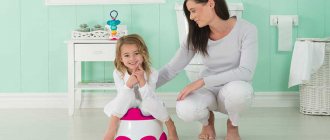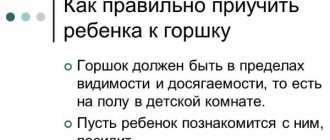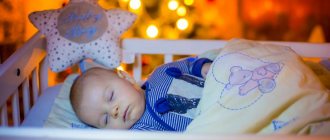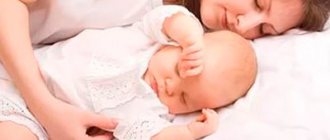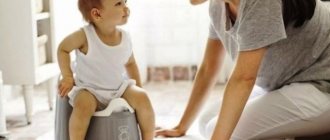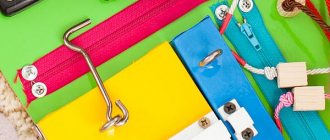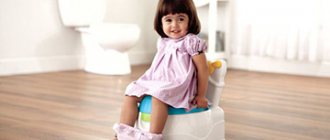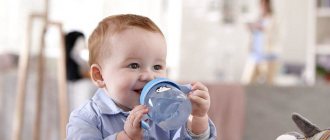How to potty train a child in one year?
Potty training a two-year-old is much easier than trying to teach toilet skills to a one-year-old. The baby is already aware of his desires and needs, understands the speech of adults and knows how to express his desires. All this will help you teach your baby to go to the toilet and refuse diapers.
When should you potty train your child?
Some parents start potty training their 8-month-old or 9-month-old baby. The mother is nervous, the child is upset, but failures come one after another. The pot remains empty, and my pants are regularly wet. Why is this happening? It’s just that the baby is not yet ready to fulfill the requirement to go to the potty. How to determine the degree of readiness? It is recommended to simply observe the child.
The toddler is ready to learn if:
- able to hold back for 2-3 hours;
- maintains approximately equal intervals between bowel movements or urination;
- has an understanding of the parts of the body (can show the part that is called);
- listens to mom;
- gradually begins to speak;
- able to show that he wants to go to the toilet (groans, strains);
- tries to take off and put on clothes independently;
- shows that dirty or wet pants irritate him.
Psychologists believe that the optimal time for potty training is 1.5 years. Some babies are ready to go potty at one year. If the mother sees that all of the listed signs are present, then you can try to potty train a one-year-old baby.
The child may be scared!
There are cases when children begin to be afraid to write only because they do not want to be scolded by their parents, and they tolerate it, which negatively affects their well-being. You shouldn’t be surprised why a child (2 years old) is afraid of the potty if his parents constantly scold and punish him for something related to the potty.
Under no circumstances should you shout at a child while urinating (for example, when he has already started peeing in his pants, you should not shout “Hey, stop!” and so on). This can cause fear and prolong the period of uncontrolled urination during sleep.
Which pots to choose for children
A significant part of your success depends on which subject you choose. The baby will spend a lot of time on it during training. Therefore, the selection of accessories should be taken responsibly. The subject must meet the general requirements:
- Be comfortable. The pot should have wide sides: when sitting, they should not cut into the delicate body.
- Be comfortable. Metal accessories are cold, while plastic ones quickly heat up upon contact with the body.
- Be made from environmentally friendly materials: cheap plastics emit harmful substances.
- Be the right size: All babies' butts are different.
- To be just a required toilet accessory, not just another toy.
- Be convenient for daily washing with hygiene products.
- Pots have anatomical features. For boys they are equipped with a slight rise. Accessories for girls are distinguished by a rounded seat.
The main requirement: the potty must be the property of the child. If there are older children in the family, everyone must wear their own accessory exclusively.
Many different options
There are also potty chairs, musical potties, toy-shaped models, transformable potties and travel options that fold and unfold. Some children initially prefer to sit on the toilet, so parents should pay attention to the child seat. Pediatricians are confident that all of the above nuances are not of fundamental importance, and the main thing is that the child perceives the potty not as a toy, but as a place to go when needed. Parents are advised to pay attention, first of all, not to the color and presence of musical accompaniment, but to the convenience, shape, and quality of the plastic. It is important that the potty heats up quickly from the baby’s body.
Are there differences in potty training a boy and a girl?
Psychologists note: the success of potty training depends on the child’s emotional readiness. The baby must understand the speech of adults and be able to restrain the first natural urge to urinate. The baby can already walk and begins to talk. He is able to listen to his mother’s demands, understand them and respond. For each baby, the favorable period occurs at a different time. And how quickly the little one comprehends this wisdom is determined by his character and state of health.
The psychological climate in the family is of considerable importance. The gender of the baby does not affect the technique of the process.
What not to do?
You cannot scold your child, humiliate him in front of other children, or set an example for him with a brother, sister, or neighbor’s child who has not peed or pooped in his pants for a long time. A friendly atmosphere in the family is the key to quickly potty training your baby.
You should not allow your baby to sit on the potty for too long. The maximum sitting time is 10 minutes.
You need to give up the brilliant idea of purchasing a small toilet seat. The child, while sitting on the accessory, should place his heels firmly on the floor, since a feeling of confidence is very important when emptying the bowel.
Psychologists do not recommend giving a child sitting on a potty a lot of toys, or reading books or telling fairy tales.
In this case, the baby’s concepts of a potty, place of play, relaxation and communication are mixed.
The strategy of behavior when potty training a child should be the same for all adults: mother, father, grandmother, nanny and other people directly involved in raising and caring for the baby must follow the same rules.
Potty training a child is a process that does not require much effort. A simple set of information and basic rules helps parents competently organize the practical process without chaos and unnecessary actions.
From 7 months, the baby can be given meat complementary foods, but it must be prepared correctly. How to cook meat for a 7 month old baby and how much can you give? We'll tell you in the next topic.
You will learn from this topic what musical toys a child under 1 year of age should have.
Methods for potty training a baby
Some mothers begin to train their baby as soon as he begins to sit up on his own. They believe that eventually a habit will become established. And it is second nature.
This technique has a drawback. When planted this way, the baby can go into the potty. But these are coincidences. They are determined by the mother’s persistence and how attentive she is to her child. The baby will begin to ask on his own no earlier than 1.5-2 years.
Others follow the opposite trend: leave everything as it is. After all, there are no normal adults who pee in their pants. Someday the baby will get tired of the inconvenience, and he will start asking for it.
But you can simply use an opportune moment: the baby’s readiness to learn a new skill. A little patience - and the problem does not exist. Moreover, there are various methods. You can choose the one you need from among them. The preparatory stage for all methods is the same: the purchased accessory is placed in the most visible place. When showing interest, the baby needs to demonstrate the purpose of the object. It is allowed to play while sitting on the potty. But it is forbidden to play it. The little one must understand: the accessory has a specific useful purpose.
In seven days
This technique allows you to teach your baby to use the potty in a week. At the same time, the baby has enough time to get acquainted with the subject and get used to the new standard of living. The second name of the technique is “Happy Baby”.
Process steps:
- The first and second days are the same. A one-and-a-half-year-old baby is introduced to a new accessory in the morning and taken out for toileting. The baby should sit for 10-15 minutes. If he does not recover, he is raised and the procedure is repeated later.
- Mom follows the baby, talks to him, plays and encourages him to recover. The TV does not turn on, only communication and active games together.
- No strangers in the house: the mother must focus on the baby.
- At each tension, the baby is placed on the potty. Mom explains to him how adults go to the toilet and how great it is to stay dry.
- On the third day, it is recommended to stop wearing diapers while walking. But you must take the potty with you. When trying to recover, the baby should be placed on the potty even during a walk. Do not pay attention to the increased interest of others: the accessory will soon cease to accompany the baby on a walk.
- From the 4th to the 7th day, the acquired skills are consolidated. With each successful attempt, the mother is recommended to praise the baby. You can tell your family about his successes and offer to praise the baby too.
It is not recommended to wear a diaper at night during training: the baby must understand that Pampers and Huggies are a thing of the past.
Potty in 3 days
The age of one and a half years is ideal for training using this method. For success, it is recommended that mommy leave everything for 3 days and devote all her time to the child. All events are divided into stages:
- On the first day, you need to start weaning your baby off diapers. It is completely excluded while staying at home. The baby sleeps, plays, does gymnastics - and all in panties.
- First, you should show your baby how to use the new item. You should take a doll (you can pee), take off its panties and put it on the potty. Then tell the child what the toy did, take the full object to the toilet, empty the contents and flush the water.
- Repeat the same with the child (when he starts to worry). Ask to pour the contents into the toilet and flush it.
- In case of an accident, be sure to ask the baby to change clothes on his own. A difficult event can cause displeasure for the little one. In this case, you should gently insist on your own. The procedure of changing clothes will be an additional incentive to ask.
- Do not scold the baby under any circumstances. When successful attempts, praise and encourage. It is acceptable to give a small gift.
On the second day, the coverage area expands. The baby is at home and goes for a walk in his pants (without diaper). The diaper is only put on at night. On the third day, the baby goes to bed without a diaper. But the mother needs to monitor his sleep: if the baby shows anxiety, he should be gently woken up and sat down to recover.
Important motivation: it's cool to be dry. Under no circumstances should you tell your baby that he has to ask or sit on the potty.
How to teach a child to ask to go potty in one day?
Yes, this is possible. This technique is suitable for those mothers who want to achieve quick results. The technique is based on sequential steps:
- getting to know a new subject;
- demonstration of use using the example of a pissing doll;
- encouragement to sit on the potty independently;
- rewarding success with something salty or sweet, which makes the child drink a lot and then pee again;
- in case of a mistake, the baby must independently change into dry underwear;
- the main motivation is to stay cool and dry: that’s what adults do.
During training, the baby stays at home. Mom puts everything aside and remains alone with him. After two successful trips to the potty in a row, you can go for a walk with the baby. There is no need to wear diapers. The night also passes without a diaper. The best time to wean off diapers is summer. Even if the baby pees on the street, it is easy to change him into dry underwear and continue the walk.
What do doctors say?
At what months or years should a child be potty trained?
Official medicine and child psychology are unanimous in their opinion.
Potty training a child is possible when the baby has a more or less mature nervous system (certain signals are sent to the brain) and he better understands his body, feels the discomfort that has arisen and can control the urge to report his “business” and run to the "mini toilet".
Not a single pediatrician or psychologist can tell mothers and grandmothers with exact certainty the specific age and exact rules for teaching a child to use an independent toilet. The best time varies between 1.5 – 2 years. The age is conditional, because each baby is unique, the physiological characteristics of the baby’s body are different and they have their own individual stages of growing up.
The views of medicine and the capabilities of the child most often do not coincide. For this reason, it is advisable to familiarize yourself with the opinions of pediatricians with some sense of doubt and under no circumstances check the tables and rush your child.
You should always remember that there is not a single healthy adult in society who does not know how to control his natural urges.
How to teach a child to get up on the potty at night?
It is recommended to carry out the training procedure only after the baby begins to go without a diaper all day. To do this, it is recommended to monitor the child’s behavior during sleep. Before peeing, the baby begins to worry. It is recommended to gently wake him up and put him on the potty. After the little one pees, he is put back into the crib. Over time, the baby will begin to wake up on his own when his bladder is full and ask to pee.
Possible problems when training a baby
Sometimes it’s impossible to teach a baby to ask his mother. There may be several reasons:
- the moment of training was poorly chosen: the baby is not ready yet;
- Recommendations are not strictly followed: the mother does not use a diaper during the day, but puts it on at night;
- the baby has learned the basics of toileting independently, but during play he gets carried away and misses the urge;
- The baby is sick or stressed.
Be that as it may, you should accurately determine the cause of the failure and continue training.
One step forward - two steps back
Often the mother herself does not have enough patience. She starts working with the child, and then guests arrive. The process goes astray, the baby plays in diapers again. And the next day he forgot everything. We have to start over. Tiny is hardly to blame for this. In this situation, it is worth remembering Gorbachev’s recommendation: “Start perestroika with yourself!”
Sometimes mommy thinks: the process is established, the baby has learned to ask. But the child turned out to be an addicted little person: during games he forgets about everything. The situation can be easily corrected: the mother should remind the child about the toilet from time to time.
If your child is afraid of the potty
Perhaps mom overdid it. She might yell at the baby, not introduce him to a new object properly, or keep him on the potty for too long. In this case, you should postpone the learning process and put the accessory away. After some time, the baby will calm down, and you can start over. Sometimes the baby shows that he doesn’t like the potty. I'm not happy with the color and it's uncomfortable to sit on. Some kids are scared of musical accessories. In this case, you need to purchase a new one.
A visit to your little friend will help rid your baby of fear. Seeing another child confidently use the accessory will help him stop being afraid. In difficult cases, you should consult a child psychologist.
Buying a pot wisely
The “object of celebration” itself is of no small importance. Whenever a child begins to accustom himself to self-hygiene procedures, you need to be especially scrupulous when buying a potty.
Main features of the accessory:
- When the baby is sitting, his legs should be at right angles. Failure to comply with this rule may result in pressure on the diaphragm and, as a result, hemorrhoids and rectal fissures.
- The potty must be stable on the floor and not wobble under any circumstances, otherwise the baby may fall.
- The design of the pot should be made in a classic style. The child should not perceive the accessory as a toy - he needs to calmly do his business and not be distracted by playful moments.
- The best material is plastic; it is never cold and the baby will not feel discomfort in the autumn-winter period.
The shape and color of the pot do not matter. But the accessory may have additional handles so that the baby can lean on them. It is advisable for mothers and fathers to refuse potties in the form of chairs, armchairs, cars, since the baby may confuse his hygiene object with real objects that are not originally intended for bowel movements.
Before purchasing a potty you like, parents should decide where it will be used. There are a huge number of children's potties that are indispensable when traveling.
- Collapsible accessories in the form of a suitcase. The material is combined: the bowl is made of thick PVC film, the back, seat legs and circle are made of plastic.
- Inflatable devices. The base is dense medical rubber. They are soft and springy.
The child does not have psychological resistance to frequent changes in habitual devices. For this reason, you need to familiarize your baby with another potty a few days before use and give him time to get used to the new item.
Many parents cannot decide which is better – a baby carrier or a car seat for newborns. Read our advice and make your choice.
At what age can a child swim with a swim ring around his neck? Read on.
Have you noticed that your child goes to the toilet with blood? The causes of the alarming symptom are described here.
